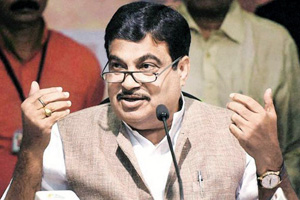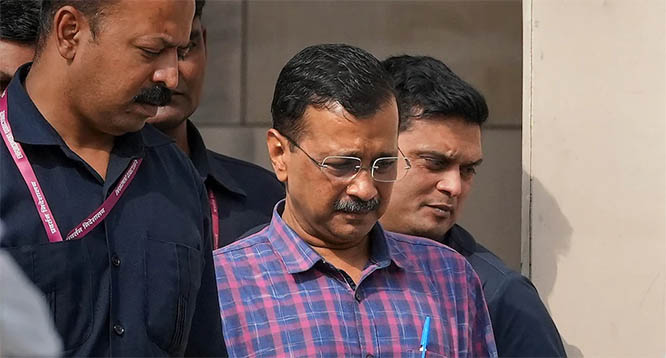New Delhi, Dec 20: When it's about highways, Nitin Gadkari -- the 'flyover man from Maharashtra' -- seems to know the way to take it to a new high and his latest is linking Delhi with Thailand for an over 4,000-km road trip in 2016.

"I don't believe in empty words... What I say I do," the Union Minister for Road Transport and Highways said while listing out his priorities for the new year.
As he sought to implement a number of initiatives in the year passing by to expand the road network in the country and removing the bottlenecks, Gadkari said his target is now to take the road building capacity to 100 km a day.
"We are building 18 km a day at present from a mere 2 km a day inherited by us from previous government," said Gadkari who had earlier this year set himself a target of 30 kms per day within two years.
"We will meet our previously announced target of 30 km a day in March 2016," he added.
"The way you travel to Mumbai on your car via Delhi, the same way you will be able to reach Thailand, hopefully, by the next year. It is a revolutionary work... People will not believe (now)," Gadkari told PTI in an interview here.
Talking about the progress made on various fronts in the roads and highways sector during 2015, Gadkari said projects worth lakhs of crores of rupees are being completed.
"Driving through India and its congested cities, towns and villages would be a breeze. Not only you can reach Bhutan and Myanmar through bigger, wider and better road network but once the Chabahar deal in Iran is clinched, you will be driving all the way to Russia and Europe via Iran and Afghanistan once you reach Chabahar via sea or air from India.
"This is the dream for which government is willing to pump lakhs of crores of rupees," he said.
"Nothing is impossible," said Gadkari who has been known as one of the key persons behind the former Prime Minister Atal Bihari Vajpayee's ambitious 'Pradhan Mantri Gram Sadak Yojna' project. The "Flyover man from Maharashtra" tag comes from his work on creating a network of flyovers and the Mumbai-Pune Expressway before he came to Centre.
"A trilateral pact between India-Myanmar-Thailand (IMT) is expected by March 2016," Gadkari said while adding that the landmark Bangladesh, Bhutan, India, Nepal (BBIN) Motor Pact has already been inked with identification of 14 routes for passenger services and 7 routes for cargo movement.
"Work on the USD 8 billion road connectivity BBIN project is likely to be completed soon with ADB funding," he said.
Once BBIN and IMT are operationalised, a seamless vehicular movement between SAARC and ASEAN nations will become a reality and "I hope that this will happen very soon", he said.
He said India will soon begin work on building a sea-bridge and a tunnel connecting Sri Lanka, while ADB is ready to fully-finance the Rs 24,000 crore project connecting Rameshwaram to Sri Lanka.
On domestic front, the targets include building up to 16 express highways, making Delhi congestion free by 2017 and laying a green canopy on thousands of kilometres of national highways. India has the world's second largest road network.
"At least Rs 5,000 crore, one per cent of the Rs 5 lakh crore worth of road projects, will be spent on greening of highways," Gadkari said.
To transform India's 96,000-km network of National Highways (NHs) into green corridors, the government has come out with a Green Highways Policy under which it will be mandatory to set aside 1 per cent of the total project cost for plantation.
"I will transform India's infrastructure in a manner that after five years, people would not be able to believe what they are seeing," Gadkari said while listing out his 'incredible-sounding' ideas.
Gadkari said he inherited Rs 3.8 lakh crore worth of stuck projects on account of land and environmental disputes. This forced developers into debt and the problem has been further compounded by the fact that 30 per cent of all loans are to the infrastructure sector.
A confident Gadkari however said the government is committed to providing at least 50 lakh jobs to people in the highways and shipping sectors.
"Our government has already awarded projects worth Rs 1 lakh crore," the minister said.
"Last year there were only 5 PPP projects. But this year, so far 9 big PPP projects are starting and bids are over. We are doing 17 projects on hybrid model and many more would follow. We would contribute at least 2 percentage points to India's GDP," he said.
"We have had a series of meetings with bankers and barring 19 of the 77 stuck projects have rolled out," Road Transport and Highways Secretary Vijay Chhiber said.
Government plans to sell 112 projects completed through government funds to foreign insurance and pension funds.
Highways Ministry has Rs 42,000 crore budgetary allocations. NHAI will raise Rs 70,000 crore from tax exempted bonds. Govt may securitise annual Rs 7,000-8,000 crore toll collection for 15 years to get Rs 1,20,000 crore.
To woo bidders, the government has allowed them to divest 100 per cent equity in highway projects two years after completion.
There are 80 Build, Operate and Transfer (BOT) projects awarded prior to 2009 that have been completed and the locked in equity in these projects works out to approximately Rs 4,500 crore.
Barely days after the policy announcement, Gammon Infrastructure, in one of the largest asset sales at one go in the infrastructure space, exited 9 projects valued at Rs 6,750 crore to Brookfield and Core Infra India Fund. The deal fetched the company Rs 563 crore and will help it reduce its debt by Rs 1,718 crore.
NHAI Chief Raghav Chandra said such deals will result in the companies ploughing back funds in highway projects.
Rating agency India Ratings estimates that out of the 86 completed projects equivalent to 5,200 km that have been completed under public private partnership, around Rs 4,000 crore of additional residual equity can be released under the proposed divestment scheme.
Projecting the country's highways sector as a "unique opportunity" for investments, the government has rolled out projects worth USD 93 billion saying investment opportunities include "new models being rolled out both for greenfield (hybrid annuity) and brownfield projects (monetisation).
Gadkari said plan is to build durable concrete roads and a portal with the initiative has resulted in booking of 95 lakh tonnes of cement online for highways apart from sale of 3 lakh tonnes by 37 cement makers.
A similar portal is planned to make available steel at competitive prices as domestic producers face an onslaught of cheaper imports from China, Japan and Korea.
Gadkari also hoped that the Bill to transform India's transport sector will soon see the light of the day.
The Road Transport and Safety Bill seeks to clamp down heavily on traffic offenders and proposes a steep penalty of up to Rs 3 lakh, along with a minimum 7-year imprisonment for death of a child, besides huge fines for other driving violations. The legislation also aims to bring down fatalities in road accidents by two lakh in the first five years.
India sees 5 lakh road accidents annually -- one of the highest in the world -- in which 1.5 lakh people lose lives while another 3 lakh are crippled for life.
As per Gadkari, other ambitious projects include a Rs 4,000 crore Metrino project that will connect the 70-km stretch from Dhaula Kuan in the national capital to Manesar in Haryana. A detailed report is being worked out for the project, under which, fully-automatic and driverless small pods would travel independently suspended over an overhead network, which is usually 5-10 meters above ground.
In an eco-friendly initiative, ISRO in collaboration with the Road Ministry is developing cost-effective lithium-ion batteries that will power electric buses in Delhi.
The government has plans to run at least 15 electric buses driven by indigenous economically viable battery.
Also on anvil is a 1,000-km Chaar Dhaam Yatra project to connect the four holy towns of Yamunotri, Gangotri, Kedarnath and Badrinath with highways at a cost of Rs 11,000 crore and a 5000-km of road network along the borders and coastal areas under 'Bharat Mala' at an estimated Rs 80,000 crore.
India has the world's second-largest road network at 4.80 million kilometers and national highways comprise 2 per cent of total road network bearing 40 per cent of total traffic and 65 per cent of freight and 80 per cent of passenger traffic. The National Highways length is about one lakh km.
Having set such ambitious targets, Gadkari has also given a stern 'perform or take VRS' warning to officials sitting on files and has asked them not to become obstacles in the way of "India achieving world class infrastructure".
The government has decided to use ISRO-aided satellites and drones to monitor its highways construction programme to fast-track building of roads.








Comments
Add new comment